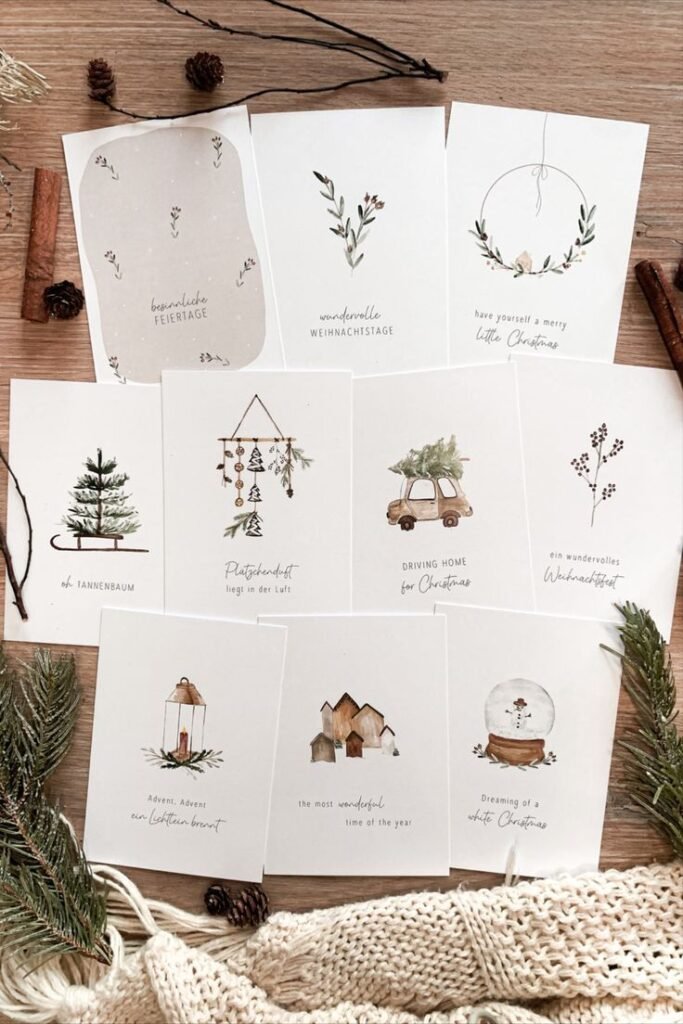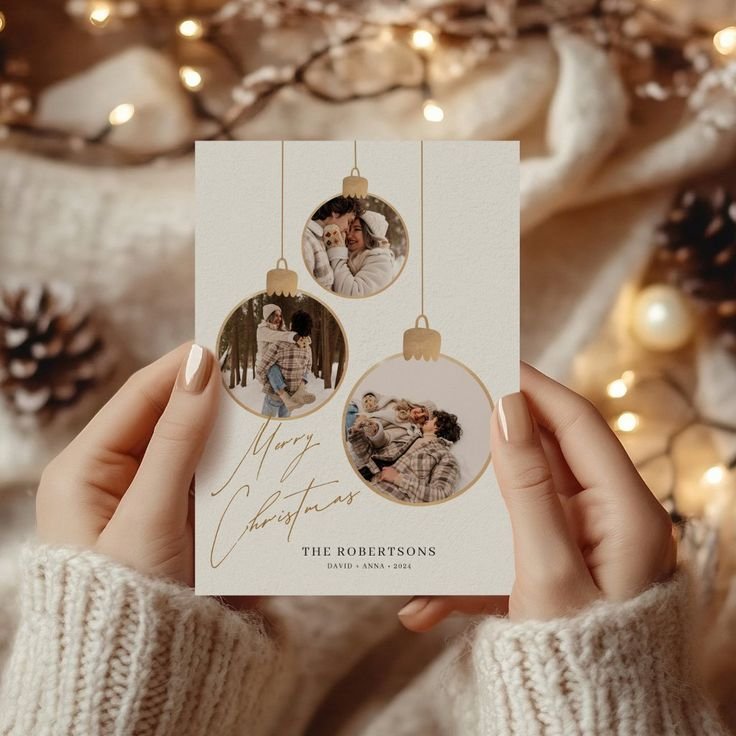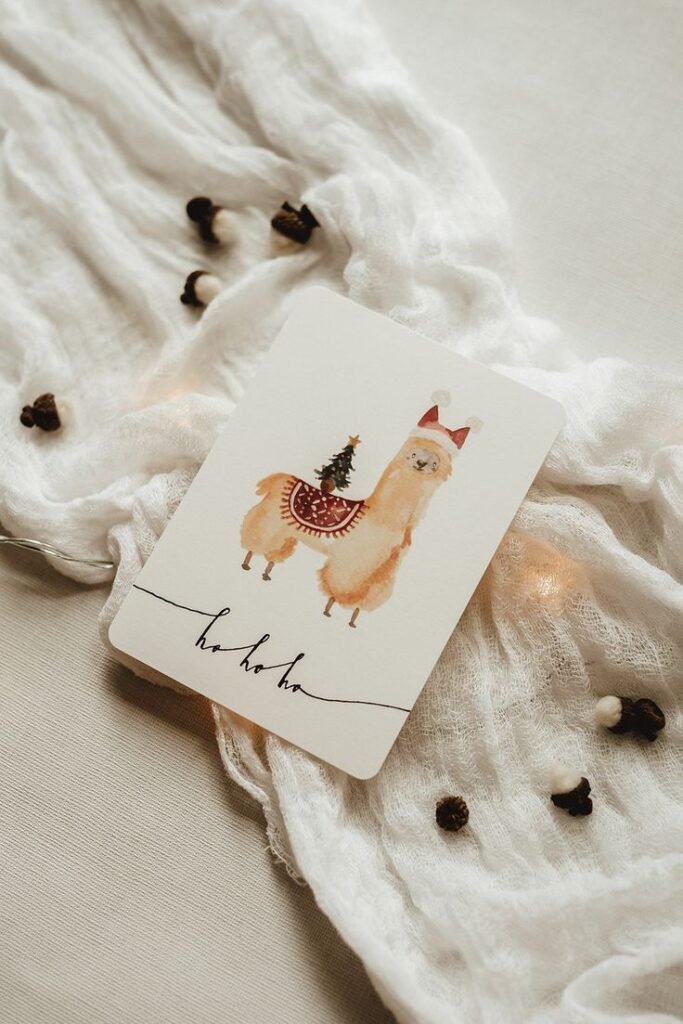The holiday season brings a unique opportunity to express your creativity while spreading joy. Creating personalized Christmas cards can make your holiday greetings even more special, making them memorable keepsakes for your loved ones. This year, consider putting in the effort to craft cards that not only convey your warm wishes but also stand out.
With a few basic supplies and some imagination, you can produce cards that reflect your personality and style. Exploring different DIY techniques will allow you to put a personal touch on your holiday outreach, ensuring that your cards are cherished long after the gifts are unwrapped.



1) Watercolor Ornament Card
Creating a watercolor ornament card is a delightful way to showcase your creativity. You can make this card using simple materials like watercolor paper, paint, and brushes.
Start by sketching festive ornaments lightly with a pencil on the card. Aim for classic shapes like balls and stars. This step gives you a guide for your painting.
Next, choose vibrant watercolor paints. Use warm colors to evoke the holiday spirit. Apply the paint with a wet brush to create a soft, blended effect.
Once the paint dries, use a fine-tip pen to add details like stripes or dots. This enhances the ornaments and gives them dimension.
For the finishing touch, add a personalized message inside. Your friends and family will appreciate the effort you put into this handmade card.


2) Pop-Up Christmas Tree Card
Creating a pop-up Christmas tree card adds a fun twist to traditional holiday greetings. You can easily make this card with basic materials.
Start with a sturdy piece of cardstock for the base. Fold it in half to create a card. For the pop-up tree, cut a triangle from green paper, then fold it accordion-style. This will form the branches of your tree.
Secure the base of the tree to the interior of the card. Make sure to glue it firmly so it pops up when opened. You can enhance your tree by adding decorations like tiny ornaments or glitter.
For a personalized touch, write a holiday message inside the card or include a family photo. Use colorful markers to add festive designs around the edges.
Experiment with different sizes and shapes for your tree to create variations. You can even make multiple pop-up cards to send to friends and family, spreading holiday cheer in a unique way.


3) Embossed Snowflake Design
An embossed snowflake design adds a touch of elegance to your Christmas cards. This technique creates a raised effect that enhances the visual appeal.
To get started, gather the materials: cardstock, an embossing folder with a snowflake pattern, and a die-cutting machine. You can also use an embossing stylus and a mat if you prefer a hand-crafted approach.
Begin by cutting your cardstock to your desired size. Place it in the embossing folder and run it through the die-cutting machine. If you are using a stylus, gently trace the snowflake pattern on your cardstock.
Once embossed, you can enhance the design by adding color. Use ink or metallic markers to highlight the snowflakes. For an added festive touch, sprinkle some glitter on the wet ink for extra shimmer.
Finish the card by adding your handwritten message inside. This personal touch will make your embossed snowflake card stand out among holiday greetings. Your recipients will appreciate the craftsmanship and thoughtfulness this design conveys.


4) Rustic Burlap Accent Card
Creating a rustic burlap accent card is an excellent way to add warmth to your holiday greetings. This card style embraces a natural aesthetic, making it perfect for those who appreciate a farmhouse charm.
Start with a sturdy card base, preferably in a neutral tone like cream or brown. Cut a piece of burlap, ensuring it’s slightly smaller than the card front. Attach the burlap using glue or double-sided tape.
Consider embellishing your card with simple decorations. Small pinecones, dried flowers, or twine can enhance the rustic feel. You can also print or handwrite your message on a smaller piece of cardstock and layer it over the burlap.
Adding a few buttons or wooden accents can personalize your card further. These materials not only add dimension but also contribute to the rustic theme.
When finished, make sure your card reflects your style. This DIY card is a thoughtful way to send your best wishes and will surely capture the recipient’s attention.


5) Quilled Paper Holiday Wreath
Creating a quilled paper holiday wreath adds a unique touch to your Christmas cards. This technique involves rolling, twisting, and shaping strips of paper into decorative elements that form a beautiful wreath.
Start by gathering materials like colored paper, a quilling tool, and glue. Cut strips of paper into various lengths and widths for a more dynamic look. You can use traditional holiday colors such as green, red, and gold to enhance the festive feel.
Begin by making small coils and teardrop shapes. These will serve as the base for your wreath. Arrange the shapes in a circular pattern and glue them as you go. This process allows for creativity, so feel free to experiment with different shapes and sizes.
Once you complete the wreath, you can attach it to a card. Write a holiday message inside for a personal touch. This DIY project offers a great way to impress friends and family while expressing your festive spirit.


History of DIY Christmas Cards
DIY Christmas cards have a rich history that reflects changes in craft materials and technology. Understanding these developments can enhance your appreciation for the creativity involved.
Evolution of Craft Materials
The origins of DIY Christmas cards can be traced back to the early 19th century. Handmade cards became popular as people sought personal ways to express holiday sentiments. Initially, cards were crafted from heavy paper, often embellished with hand-painted designs or intricate cut-outs.
As the years progressed, craft materials evolved. In the 20th century, advancements included the introduction of colored papers, markers, and stickers, which made crafting more accessible.
Consumers began to favor convenience, leading to the rise of commercially produced cards. Despite this trend, many individuals still embraced DIY techniques. They sought unique ways to personalize their greetings, blending traditional methods with modern materials.
Influence of Technological Advancements
The late 20th century marked significant technological advancements that impacted DIY card-making. The introduction of home computers and printers allowed people to design and print their own cards, expanding creative possibilities.
You can now easily incorporate digital images, graphics, and fonts into your card designs. Online platforms offer templates and tutorials, making it simple for you to create professionally styled cards from home.
Social media also plays a role in influencing DIY trends. Sharing ideas and showcasing designs is now more accessible than ever, encouraging a vibrant community of card makers. This interconnectedness continuously inspires new techniques and styles for DIY Christmas cards.
Creative Techniques for Christmas Cards
Embracing creative techniques can elevate your Christmas cards this season. By incorporating modern design trends and utilizing eco-friendly materials, you can craft cards that are both stylish and sustainable.
Incorporating Modern Design Trends
Modern design trends often emphasize minimalism, bold colors, and unique typography. To achieve this, consider using a sleek layout with ample whitespace.
- Typography: Choose modern fonts that stand out, such as sans-serif or quirky handwritten styles. Layering different font sizes can create visual interest.
- Color Palettes: Utilize non-traditional colors like deep teal or metallics. Combining muted tones with pops of color can make your card pop.
- Geometric Shapes: Use geometric patterns or shapes to add depth. They can serve as backgrounds or subtle accents around your text.
This approach not only makes your card visually appealing but also keeps it contemporary. Integrating such elements ensures that your Christmas card resonates with modern aesthetics.
Utilizing Eco-Friendly Materials
Sustainable materials are increasingly popular in DIY projects. Using eco-friendly options not only benefits the planet but also adds a unique touch to your cards.
- Recycled Paper: Opt for cards made from recycled materials. This choice reduces waste and offers a rustic charm.
- Natural Inks: Consider using vegetable-based inks for printing. They are less harmful to the environment and can provide vibrant colors.
- Plantable Cards: Explore plantable options that can grow into flowers or herbs. These cards provide a lasting gift beyond the holiday.
By selecting sustainable materials, your Christmas cards can reflect your values while delighting recipients. This thoughtful choice makes your cards stand out for both design and substance.









